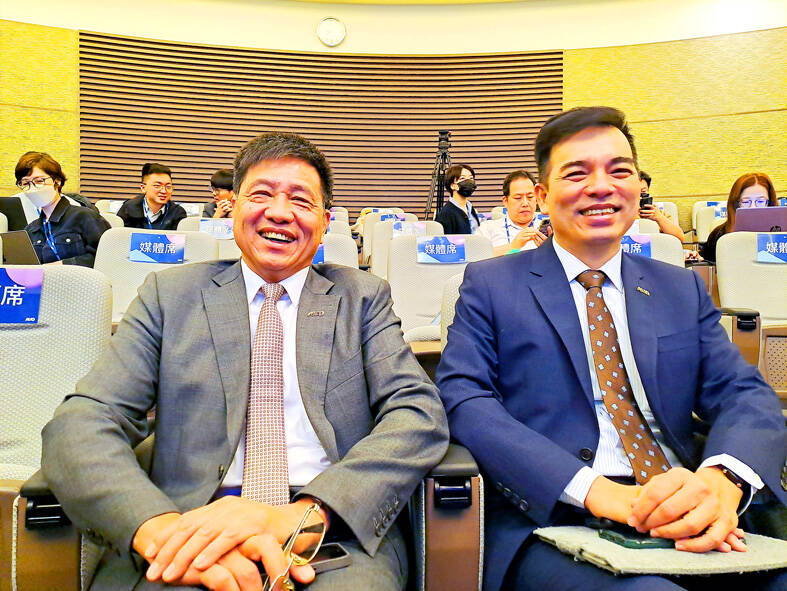Demand for PC flat panels has risen substantially in the past few months, indicating that the channel inventory correction cycle could bottom out next month after an 18-month digestion period, panelmaker AUO Corp (友達) said yesterday.
Industry analysts have been watching the PC panel sector in anticipation of a recovery, after the TV panel sector recovered last quarter. TV and PC panels are the two largest flat-panel sectors.
“We are seeing normal PC panel demand returning gradually, as opposed to rushed orders,” AUO chairman Paul Peng (彭双浪) told reporters on the sidelines of a green energy exhibition.

Photo: CNA
“PC panel inventory is glowing, returning to a healthy level,” he added.
Peng said he expects flat-panel demand to return to normal in the second half of this year.
Improvement can also be seen in panel prices, which are moving in a positive direction, he said.
Peng said he expects panel demand to better match supply in the next upcycle, given that no new capacity has been deployed by global panel manufacturers over the past two years.
AUO said it is expanding its businesses beyond flat panels, to cushion the firm from the shocks experienced during the flat panel industry’s boom-and-bust cycles.
The company aims to expand revenue contribution from its non-panel businesses to 20 percent in 2025, from 14 percent last year.
Among its non-panel businesses, AUO Envirotech Inc (友達宇沛) had the best growth momentum, with annual compound growth of 76 percent from 2020 through last year, the company said.
AUO Envirotech helps enterprises manage their consumption of water and electricity, it said.
AUO’s energy business helps customers assemble solar panels and operates solar farms. As of last year, the business unit has installed 500 megawatts of solar panels.
Shareholders have criticized AUO’s plan to distribute a cash dividend of NT$0.8. per share, as approved by its board of directors.
Peng said the company would usually not distribute a cash dividend when the company’s financial performance has drifted in the red.
This year is an exception, as AUO plans to allocate its capital surplus to fund the payment, the company said in a filing with the Taiwan Stock Exchange.
The cash dividend implies a yield of 4.44 percent compared with the stock’s closing price of NT$18 yesterday, Peng said.
Asked about progress in diversifying production sites, AUO said it is scouting sites for a production line in North America to assemble flat-panel modules for vehicles.
As vehicle displays become larger, customers are requesting panels locally to save on transportation fees, Peng said.
“As long as the China-US standoff persists, it is inevitable that companies will adopt the ‘China Plus One’ strategy to build manufacturing capacity outside of China,” Peng said.
The company has approved a NT$1 billion fund to build a new panel assembly line in Vietnam.Production is to begin in the first quarter next year.

Taiwan Semiconductor Manufacturing Co (TSMC, 台積電) last week recorded an increase in the number of shareholders to the highest in almost eight months, despite its share price falling 3.38 percent from the previous week, Taiwan Stock Exchange data released on Saturday showed. As of Friday, TSMC had 1.88 million shareholders, the most since the week of April 25 and an increase of 31,870 from the previous week, the data showed. The number of shareholders jumped despite a drop of NT$50 (US$1.59), or 3.38 percent, in TSMC’s share price from a week earlier to NT$1,430, as investors took profits from their earlier gains

In a high-security Shenzhen laboratory, Chinese scientists have built what Washington has spent years trying to prevent: a prototype of a machine capable of producing the cutting-edge semiconductor chips that power artificial intelligence (AI), smartphones and weapons central to Western military dominance, Reuters has learned. Completed early this year and undergoing testing, the prototype fills nearly an entire factory floor. It was built by a team of former engineers from Dutch semiconductor giant ASML who reverse-engineered the company’s extreme ultraviolet lithography (EUV) machines, according to two people with knowledge of the project. EUV machines sit at the heart of a technological Cold

Taiwan’s long-term economic competitiveness will hinge not only on national champions like Taiwan Semiconductor Manufacturing Co. (TSMC, 台積電) but also on the widespread adoption of artificial intelligence (AI) and other emerging technologies, a US-based scholar has said. At a lecture in Taipei on Tuesday, Jeffrey Ding, assistant professor of political science at the George Washington University and author of "Technology and the Rise of Great Powers," argued that historical experience shows that general-purpose technologies (GPTs) — such as electricity, computers and now AI — shape long-term economic advantages through their diffusion across the broader economy. "What really matters is not who pioneers

TAIWAN VALUE CHAIN: Foxtron is to fully own Luxgen following the transaction and it plans to launch a new electric model, the Foxtron Bria, in Taiwan next year Yulon Motor Co (裕隆汽車) yesterday said that its board of directors approved the disposal of its electric vehicle (EV) unit, Luxgen Motor Co (納智捷汽車), to Foxtron Vehicle Technologies Co (鴻華先進) for NT$787.6 million (US$24.98 million). Foxtron, a half-half joint venture between Yulon affiliate Hua-Chuang Automobile Information Technical Center Co (華創車電) and Hon Hai Precision Industry Co (鴻海精密), expects to wrap up the deal in the first quarter of next year. Foxtron would fully own Luxgen following the transaction, including five car distributing companies, outlets and all employees. The deal is subject to the approval of the Fair Trade Commission, Foxtron said. “Foxtron will be